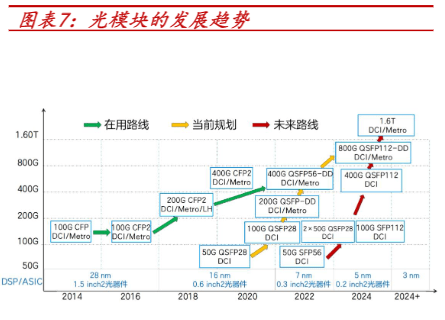
With the surge in demand for artificial intelligence, optical module products will continue to be updated to adapt to the development trends of high speed and new technologies
Zhongji InnoLight (300308.SZ), as a leader in the optical module industry, recently announced that its important AI customers have put forward demands for 1.6T optical modules to meet the needs of future GPUs with higher bandwidth and computing power. need. The company is expected to achieve mass production of 1.6T optical modules in 2025

With the rise of industries such as artificial intelligence, big data, cloud computing, 5G and the Internet of Things, optical modules are one of the core components in optical fiber communication systems, and their functional requirements in realizing photoelectric signal conversion are also growing rapidly.
With the continuous expansion of the telecommunications market and data centers, the maturity and cost reduction of optical communication technology, and the explosion of AI computing power demand, the optical module industry is ushering in rapid development
According to Light Counting’s forecast, the compound annual growth rate of the optical module market from 2021 to 2025 is expected to be 11%. As the demand for AI computing power explodes, the demand for data transmission hardware will grow rapidly. This is an inevitable trend. A research report from Soochow Securities pointed out that by 2030, the size of the global AI computing power-related optical module market is expected to exceed US$70 billion

It should be noted that the demand for data and high-speed networks continues to grow, further promoting the upgrading of optical module products. Among them, big data, cloud computing, artificial intelligence and other technologies are developing rapidly, and the amount of data is growing exponentially. In order to meet the needs of these applications, optical modules need to provide higher bandwidth to transmit large amounts of data.
In addition, applications such as high-definition video, virtual reality, and online games also have higher requirements for network transmission speed, so these fields also place higher bandwidth requirements on optical modules.
Currently, the bandwidth of optical modules has developed from 40G, 100G, 200G, and 400G to 800G, 1.6T or even higher levels

Currently, 800G high-speed optical module products are gradually replacing 200G and 400G products, which is a trend worthy of attention for AI customers. AI customers require optical module manufacturers to continuously introduce optical modules with lower power consumption, higher speed, and more reliability to meet the development needs of AI models and applications. Zhongji InnoLight also pointed out that the demand for 800G optical modules from the company's key customers next year will increase several times compared with this year, and customers have also put forward demand for 1.6T optical modules. This shows that the AI industry’s requirements for optical module products are becoming more and more stringent, and the demand for bandwidth is also increasing
According to Zheshang Securities, the 1.6T optical module in the optical communication field has a data transmission rate of 1.6 trillion bits per second, which represents advanced optical communication technology and high bandwidth requirements. Small batch shipments are expected in the second half of next year, and the upgrade cycle will be significantly shortened, about a year in advance. Nvidia, Google, Amazon and other companies may become the main customers for 1.6T optical modules
CITIC Securities believes that the domestic supply chain of optical modules is complete and can be exported overseas. Compared with other fields of optical communications, the performance of optical modules has greater flexibility. As the prosperity of the high-speed optical module industry continues to increase, huge market demand will give industry leaders the opportunity to occupy more market shares and fully enjoy the dividends brought by industry development
Zhongji InnoLight is a professional supplier of high-speed optical module solutions. It has achieved good revenue results in recent years and continues to strengthen its investment layout in the entire chain of the optoelectronic industry. The company plans to conduct testing, certification and small batch demand for the 1.6T optical modules produced in 2024, and real mass production will begin in 2025
Xinyi Sheng is a leading optical module solution and service provider, focusing on the research, development, production and sales of various high-performance optical modules and optical devices. Its products are widely used in cloud computing data centers, data communications, 5G wireless networks, smart grids and other fields. As the demand for cloud computing and artificial intelligence continues to grow, 800G optical modules will usher in new development opportunities. Xinyi Sheng has fully deployed in the 800G field and will continue to promote the upgrading of products
Fiberhome Communications is an internationally renowned provider of information and communication network products and solutions. It has a complete industrial chain in the fields of optical networks and digital applications, including optical fibers, optical cables, chips and system equipment. At the same time, FiberHome Cloud Operating System has also successfully served multiple cloud projects
The above is the detailed content of The demand for AI computing power is increasing by leaps and bounds, promoting iterative updates of optical module products, and the demand for 1.6T broadband may flourish.. For more information, please follow other related articles on the PHP Chinese website!
 How to turn off real-time protection in Windows Security Center
How to turn off real-time protection in Windows Security Center
 How to modify the text on the picture
How to modify the text on the picture
 What is the difference between wechat and WeChat?
What is the difference between wechat and WeChat?
 How to solve parse error
How to solve parse error
 How to download nvidia control panel
How to download nvidia control panel
 Advantages of plc control system
Advantages of plc control system
 Connected but unable to access the internet
Connected but unable to access the internet
 ajax tutorial
ajax tutorial




